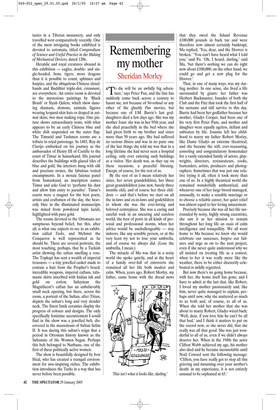Turkish delights
Philippa Scott
Turks: A Journey of a Thousand Years, 600–1600 The Royal Academy, until 12 April.
‘The Terrible Turk’ was a threat made by mothers to recalcitrant children in the time of the Mongols, while for centuries in the Caucasus women sang a very different refrain to their daughters: ‘Live among diamonds and splendour as the wife of the Sultan.’ No longer the enemy at the gates, the Turks are here, and have set up camp at the Royal Academy in a blockbuster show. Joining the EU is their latest campaign, and they have pulled out all the stops to show us who they are. This exhibition introduces the Turks from their own perspective, and offers more than simply an array of glittering objects and gleaming silks, though these are also here in abundance.
The story begins in the vast expanse of the Central Asian Steppes. Turkic tribes Scythians, Sarmatians, Alans, etc. — had already been moving westwards for 1,000 years before the exhibition’s arbitrary starting point of AD600, but, never mind, 1,000 years is a good span for a superb exhibition, and brings us to the high point of Ottoman art and culture.
In the 7th century, the Turkic tribes in Central Asia were nomadic animists and sky-worshipping shamanists. Over the centuries, they encountered different religions and cultures, whose influences were adopted and assimilated: Buddhism, Manichaeism, Christianity, Judaism (an entire Turkic tribe, the Khazars, converted) and finally Islam. On show, for example, is a boulder with an 8th-century inscription in Turkic runic script. There, second line down, to the left, is what seems to be a geometricised tulip form, a special feature of village rugs from Ladik and Konya. Did the Turks bring this motif with them from the Steppes? Patterns linger, though their significance may change or be forgotten, and carpets carry many messages.
Fragments of fragile frescoes chipped from the walls of desert caves along the Silk Route recall the time of the Uyghurs. The Uyghurs were a confederation of nine Turkish tribes who formed a stable and united empire from c.74 to 840, in Mongolia, and it was because of their support that the T’ang Dynasty survived as long as it did. Around this time the Turks encountered Nestorian Christians, whose missionaries carried their faith as far as China.
The exhibition really gets into its stride with the Great Seljuks, who established their dynasty in 11th-century Persia, and then moved into Anatolia where they became the Seljuks of Rum, and built Konya as their capital. The great doors of the Ulu Cami of Cisme are here, the missing pair to their dragon handles is in the David Museum in Copenhagen. In the Seljuk rooms are 13thand 14th-century carpets, one completely covered in a design formed by stylised, geometric, backto-back dragons. Another shows the ageold conflict between dragon and phoenix, another a design of birds, another lions within lions. Similar rugs appear in many Italian paintings and frescoes. This particular lion rug, however, survived the cen turies in a Tibetan monastery, and only travelled west comparatively recently. One of the most intriguing books exhibited is devoted to automata, titled Compendium of Science and Useful Practice in the Making of Mechanical Devices, dated 1206.
Heraldic and royal creatures abound in this exhibition — eagles, doubleand single-headed, lions, tigers, more dragons than it is possible to count, sphinxes and harpies, and the ubiquitous Chinese cloudbands and Buddhist triple-dot, cintamani, are everywhere. An entire room is devoted to the mysterious paintings by ‘Black Brush’ or Siyah Qalem, which show dancing shamans, demons, animals, figures wearing leopard-skin hats or draped in animal skins, two men making rope. One picture shows extraordinary tents, with what appears to be an early Chinese blue and white dish suspended on the outer flap. The Timurid and Turkmen rooms are a tribute to royal patronage. In 1403, Ruy de Clavijo embarked on his journey as the ambassador of Henry III of Castille to the court of Timur in Samarkand. His journal describes the buildings with glazed tiles of blue and gold, the interiors hung with silk and precious stones, the fabulous tented encampments. In a mosaic faience panel from Samarkand, an inscription names Timur and asks God to ‘perfume his dust and allow him entry to paradise’. Timur’s courts were a magnet for the best poets, artists and craftsmen of the day, the heavenly blue in the illuminated manuscripts was mixed from powdered lapis lazuli, highlighted with pure gold.
The rooms devoted to the Ottomans are sumptuous beyond belief, but this, after all, is what one expects to see in an exhibition called Turks, and Mehmet the Conqueror is well represented as he should be. There are several portraits, the most touching, perhaps, that by a Turkish artist showing the sultan smelling a rose. The Topkapi has sent a wealth of imperial treasures — a tiny jewelled casket made to contain a hair from the Prophet’s beard, incredible weapons, imperial caftans, talismanic shirts inscribed with Indian ink and gold on cotton. Suleyman the Magnificent’s caftan has an unbelievably small neck opening, but there, across the room, a portrait of the Sultan, after Titian, depicts the sultan’s long and very slender neck. The finest Iznik ceramics display the progress of colours and designs. The only specifically feminine accoutrement I could find in the show was a jewelled belt, discovered in the mausoleum of Sultan Selim II. It was during this sultan’s reign that a period in Ottoman history known as the Sultanate of the Women began. Perhaps this belt belonged to Nurbanu, one of the first of these politically active women.
The show is beautifully designed by Ivor Heal, who has created a tranquil environment for awe-inspiring riches. The exhibition introduces the Turks in a way that has never before been possible.
















































 Previous page
Previous page